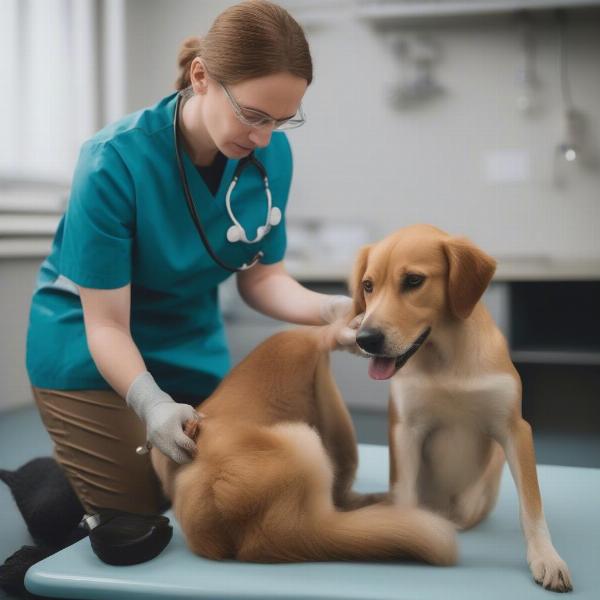A dog’s front legs are essential for mobility, balance, and overall well-being. Understanding their structure and function is crucial for every dog owner, allowing you to recognize potential problems early on and ensure your furry friend stays active and healthy. This article will delve into the intricacies of dog front legs, covering everything from anatomy and common ailments to preventative care and treatment options.
Anatomy of a Dog’s Front Leg
Unlike human arms, a dog’s front legs aren’t directly attached to the skeleton. Instead, they are connected by powerful muscles and ligaments, forming a flexible and robust structure. The main components include the scapula (shoulder blade), humerus (upper arm), radius and ulna (forearm), carpus (wrist), metacarpals (paw bones), and phalanges (toes). Each part plays a vital role in weight-bearing, movement, and shock absorption.
The scapula, a flat, triangular bone, provides a wide range of motion for the shoulder joint. The humerus connects the scapula to the forearm bones, the radius and ulna. These bones work together to facilitate rotation and flexibility in the leg. The carpus acts as the dog’s wrist, allowing for bending and shock absorption. The paw consists of metacarpals and phalanges, providing support and traction.
Common Front Leg Problems in Dogs
Several issues can affect a dog’s front legs, ranging from minor injuries to more serious conditions. Some common problems include:
- Lameness: This is often the first sign of a problem and can be caused by various factors, including sprains, strains, fractures, or arthritis.
- Elbow Dysplasia: A genetic condition affecting the elbow joint, leading to pain, lameness, and arthritis.
- Osteochondritis Dissecans (OCD): A developmental disease where cartilage in the joint doesn’t form properly, causing pain and inflammation.
- Arthritis: This degenerative joint disease can cause pain, stiffness, and reduced mobility.
- Fractures: Breaks in the bones can occur due to trauma or underlying bone conditions.
Caring for Your Dog’s Front Legs
Preventative care is key to maintaining the health of your dog’s front legs. Here are some essential tips:
- Maintain a Healthy Weight: Excess weight puts extra strain on joints, increasing the risk of injuries and arthritis.
- Regular Exercise: Provide appropriate exercise for your dog’s breed and age. dog front leg wheelchair can help dogs with mobility issues stay active.
- Supplements: Joint supplements containing glucosamine and chondroitin can help support cartilage health and reduce inflammation.
- Proper Nutrition: A balanced diet rich in essential nutrients is crucial for bone and joint health.
When to Seek Veterinary Care
If you notice any signs of lameness, swelling, or pain in your dog’s front legs, it’s essential to seek veterinary care promptly. Early diagnosis and treatment can significantly improve outcomes and prevent long-term complications. Your veterinarian will conduct a thorough examination, including X-rays or other diagnostic tests, to determine the underlying cause of the problem and recommend appropriate treatment options. dog front leg amputation may be necessary in severe cases. splint dog front leg or wrist brace carpal dog front leg brace might be recommended for certain injuries.
 Veterinarian Examining Dog's Front Leg
Veterinarian Examining Dog's Front Leg
Conclusion
Your dog’s front legs are vital for their mobility and quality of life. By understanding their anatomy, common problems, and preventative care strategies, you can help ensure your furry friend stays active and healthy for years to come. Don’t hesitate to contact your veterinarian if you have any concerns about your dog’s front legs.
FAQ
-
What are the signs of a front leg injury in a dog? Lameness, limping, swelling, pain, reluctance to put weight on the leg, and unusual posture.
-
How can I prevent front leg problems in my dog? Maintain a healthy weight, provide regular exercise, offer joint supplements, and feed a balanced diet.
-
What are the treatment options for front leg injuries? Treatment depends on the specific injury and may include rest, medication, physical therapy, surgery, dog front leg splint, or bracing.
-
What is elbow dysplasia? A genetic condition affecting the elbow joint, often leading to arthritis and lameness.
-
How can I tell if my dog has arthritis in its front legs? Signs include stiffness, lameness, difficulty getting up or down, and reduced activity levels.
-
Is amputation ever necessary for front leg problems? In severe cases, such as bone cancer or irreparable injuries, amputation may be the best option for improving the dog’s quality of life.
-
What are some good exercises for dogs with front leg problems? Consult with your veterinarian or a canine rehabilitation specialist for tailored exercises. Low-impact activities like swimming or short walks on soft surfaces might be recommended.
About ILM Dog: ILM Dog is your trusted resource for expert advice on all aspects of dog care, from breed selection and health to training and nutrition. We provide comprehensive information and resources to help dog owners worldwide ensure the well-being of their canine companions. Whether you’re a new dog owner or a seasoned pro, ILM Dog is here to support you every step of the way. We specialize in Dog Breeds and Selection, Health and Medical Care, Training and Behavior, Nutrition and Feeding, Grooming and Hygiene, and Products and Accessories. Contact us at [email protected] or +44 20-3965-8624 for personalized guidance.